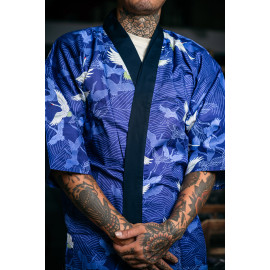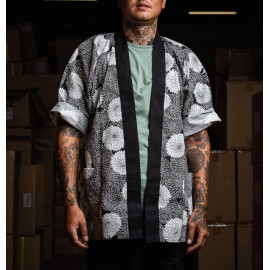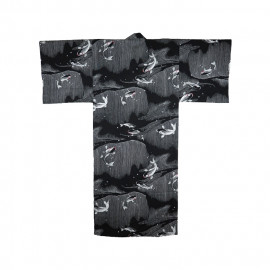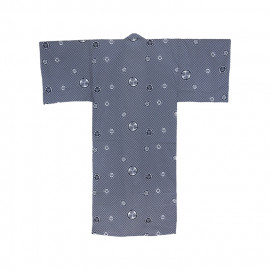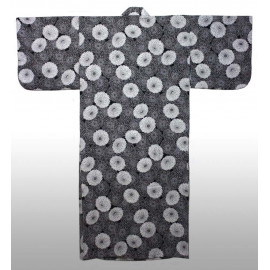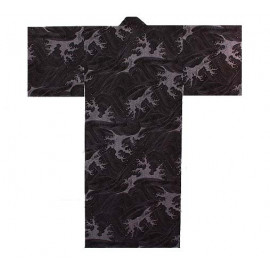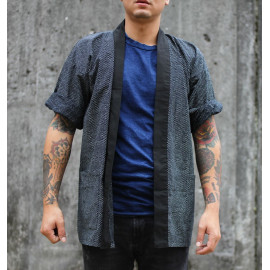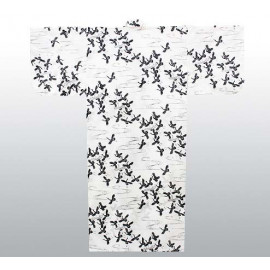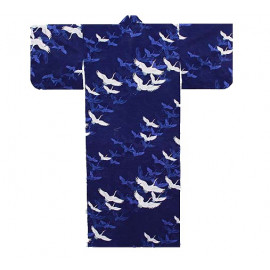No products
Kimonos
The japanese kimono is a traditional garment that is, a real symbol of the japanese culture. It should not be confused with the clothing used for the martial arts. Previously, the japanese kimono was worn by all the japanese and was used as a garment of everyday life. It is now worn for special occasions such as weddings or other ceremonies, and as an article of clothing for summer (yukata). With the exception of the Yukata which is a japanese kimono of lightweight cotton, the other kimonos are usually made of silk, wool or linen. The yukatas are easier to put on and are washable at home without any problem.
The japanese kimono is a traditional garment that is, a real symbol of the japanese culture. It should not be confused with the clothing used for the martial arts. Previously, the japanese kimono was worn by all the japanese and was used as a garment of everyday life. It is now worn for special occasions such as weddings or other ceremonies, and as an article of clothing for summer (yukata). With the exception of the Yukata which is a japanese kimono of lightweight cotton, the other kimonos are usually made of silk, wool or linen. The yukatas are easier to put on and are washable at home without any problem.
-
Si l’on voulait traduire le mot kimono, on obtiendrait « quelque chose que l’on porte sur soi ». Ce vêtement est considéré aujourd’hui comme le vêtement traditionnel japonais, alors qu’autrefois, c’était l’habit que l’on portait tous les jours.
Au VIIe siècle, le kimono faisait office de sous-vêtement. Les Japonais y ajoutaient alors un pantalon ou une jupe. A cette époque, les différentes classes sociales étaient très marquées, et cela se voyait notamment au travers de codes vestimentaires. La qualité des kimonos dépendait de la classe sociale.
Le mot kimono fait son apparition au XIIIe siècle, et désigne alors le kosode : un vêtement aux manches étroites (par opposition aux osode, des vêtements aux manches longues). Les modèles gagnent en raffinement et le vêtement devient objet de luxe.
Il est aujourd’hui réservé aux grandes occasions et reste onéreux pour qui veut l’acheter neuf.
-
Il est facile de confondre le kimono traditionnel avec le yukata japonais. Si ce sont tous les deux des vêtements traditionnels, ils présentent un certain nombre de différences.
La plus grande d’entre elles se situe au niveau du tissu. Le kimono est conçu à partir d’un tissu en soie, souvent orné de dessins brochés en fil d’or et d’argent.
Le yukata japonais est quant à lui fabriqué à parti de coton. En effet, il se destine à être porté dès qu’il commence à faire chaud. Le coton laisse respirer, est léger et absorbe l’humidité du corps.
Sous le kimono traditionnel japonais, les Nippons portent un nagajuban, une doublure en soie ou en coton pour protéger le kimono de la sueur. Sous le yukata, jus des sous-vêtements !
-
Pour bien porter votre kimono, veillez à croiser le côté gauche sur le droit (l’inverse étant réservé aux personnes décédées !).
Au Japon, les kimonos sont réservés aux grandes occasions, en raison du prix élevé d’achat. Ceci est dû aux fils d’or et d’argent qui composent le vêtement. Ces grandes occasions désignent par exemple des cérémonies, des événements traditionnels, le jour de sa remise de diplôme, de son mariage ou encore lors de la cérémonie du thé.
Si vous voulez l’utiliser à la façon occidentale, portez-le comme un manteau ou une veste et laissez-le pendre librement sur vous.
-
Made in Japan vous propose votre yukata avec plusieurs motifs au choix : des vagues, des cigognes ou encore des chrysanthèmes. Vous retrouvez donc des motifs liés à la nature, thème cher aux Nippons et à nos maîtres artisans.
Bon à savoir : dans la culture japonaise, le chrysanthème jaune symbolise le soleil et la lumière, et donc l’immortalité. Et dans tous les pays asiatiques, la fleur représente le symbole ultime du bonheur et de la bonne santé.
Le thème de l’immortalité se retrouve d’ailleurs avec la cigogne puisque l’oiseau la symbolise. Elle représente aussi la longévité. Ceci est dû au fait que les Japonais pensent que l’animal peut atteindre un âge avancé.
Discover other product categories

The Furoshiki is a japanese art designating the packing and decorating gifts or everyday objects in order to offer or carry. The method is to use pieces of tissue, very often of a square shape and fold it or tie it in order to pack the object. Several folding techniques are used in order to adapt to all types of objects. There are different materials : silk, cotton, nylon,... Formerly widely used in Japan, the Furoshiki is making a big comeback, offering a more environmentally friendly and more sympathetic to wrap your gift.
On the shop Made in Japan, you will also find small bags and pouches japanese ultra-resistant hand-crafted by our master craftsmen in japanese. The patterns, colors and materials used in the design of these bags and pouches japanese reflect fully the culture in japan.

In japan, the bento is a item This is not a simple way to carry meals, it is the art and how to provide a balanced meal highlighting the food of playful and sophisticated.
In general the box at bento japanese is divided into different categories : the largest for starchy foods such as rice or pasta, the second for the protein, such as salmon, the third for vegetables and the fourth for dessert.
In Japan, these bento boxes japanese are very used and you can buy compositions of bento from the supermarket very easily. It is also used to make fun food preparation for children presenting them in bento boxes japanese food in an original way, with cutouts in the shape of characters or animals for example.
